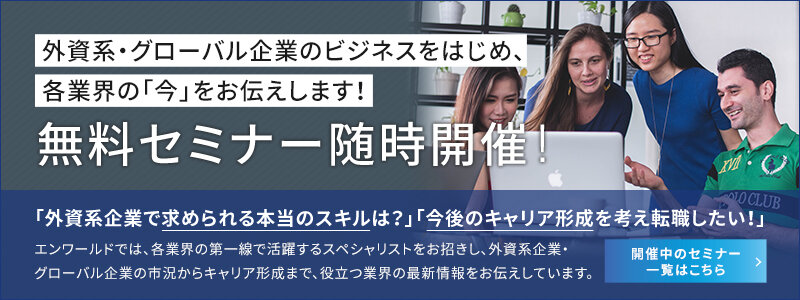Published Date :

How can you make your presentations more effective?
hanks to the COVID-19 pandemic, meetings using online conference services like Zoom, Skype, and Teams have become routine. Now that online communication has gone mainstream, are the presentations you are making to your boss, staff, suppliers, and customers as effective as they could be?Today, we will hear from Lead Presentation Producer Eiichiro Takahashi of Presentation Planning, a company that meets a range of needs, from the basics to the unique aspects of online presentations, content design, materials, production, and practice.
Part#1 - Presentations are meant to grab and move your audience
Introduction - The essence of a presentation is unchanged, regardless of whether it is online or offline
When I ask people, “What is a presentation?” most reply, “Telling people what you think.” But this is not the true definition of a presentation.
The goal of a presentation, at its root, is to generate action, whether it is to move the audience to buy a product, or to accept a plan or proposal. A presentation only succeeds if the audience is moved to action as a result of you telling them your thoughts.
I would bluntly define a presentation as “the act of sharing your thoughts to solicit a change from the audience.”

This is the flow that makes a presentation.
Aim for Presentation 3.0
Presentation is an essential skill in business, but some people end up forgetting that it is the audience that has the starring role. When I talk about presentations, I use the phrase “Presentation 3.0.” “3.0” implies that there is a 1.0 and a 2.0. Let’s take a look at each of them.
Unfortunately, the most common mode is Presentation 1.0 –when you speak at your pace, with no regard at all for the audience. There are plenty of folks who think that a presentation is just an opportunity to say what they want.
If you have been in such an audience, you know that you lose your will to listen to presenters who just run through their presentations. That is why such a presentation will not achieve its goal of selling a product or having a plan or proposal accepted.
Presentation 2.0 is a presentation in which the speaker shows proper awareness of the audience. However, a presentation that only “communicates the content” does not achieve its goal. Of course, the content is necessary, but a presentation needs to convey the benefits of the product or service to those listening, to the point of influencing their behavior.
That is the next step: Presentation 3.0. This is a presentation in which you communicate your ideas and move your audience. Go for Presentation 3.0!
The basic SWP-type presentation to move your audience
As your basic model for presentations, I recommend the SWP (Super-Whole-Parts) method. Originally, there was the “Whole-Parts” style of discourse. You would begin a presentation by setting out the “Whole” (the conclusion to be conveyed to the audience), followed by an explanation of the “Parts” (details), before returning to the “Whole” (the conclusion) to wrap up.
The SWP method is a bit of an upgrade to this model. As seen in the figure below, the SWP method sets out a flow: from Intro to Essential point to prelude to the Details to DetailsA, B, C to Recap of details to Essential point to Concrete proposal. This model is appropriate for most presentations about services, products, plans, and ideas.
Now, let’s create a presentation about clocks using the SWP method.
Intro
This is a presentation that will deliver useful information to those looking for a clock.
Essential point
This product is a “Park Clock” from an overseas furniture retailer. I am about to give you three reasons why this is a great clock.
Prelude to the details
The first reason is the design, the second is the function, and the third is the price. I will now make a presentation on clocks based on these three points.
Details A, B, C
The first is the design. As you can see, this clock is stylish and attractive, designed to look like a clock in the park. It’s around 15 centimeters high. I have one on my desk, and it doesn’t get in the way at all. Now onto the second point: function. It looks like an inexpensive kitchen clock, so I was worried that it might not work. But it keeps the right time, and it works perfectly.
Finally, the third point: price. This clock costs 600 yen, but it is now on sale for 300 yen. I am quite surprised to be able to buy such a nicely designed clock for 300 yen.
Recap of details
There you have it –it’s an attractive and stylish design. The second point is that it works perfectly, and the third is that it is cheap. I would recommend it to you.
Essential point
This clock can be purchased online at the furniture retailer’s website, but if you buy just one, the shipping is around 1,000 yen, so you will be paying more for freight than for the product itself. And yet, due to its limited number of retail outlets, you may well find yourself unable to go and buy it.
Specific proposal
If that is you, you should definitely use a flea market app. I bought this clock using a flea market app. On an app like this, the clock costs around 650 yen. But if you take into account transport fares and time, it works out to be cheaper. If you are interested, take a look at downloading a flea market app.
Part#2 - Preparation and delivery of an influential Presentation 3.0

2 - 1. Preparing: Rules for making presentation materials
I would recommend making your presentation materials as simple as possible. That is because “slides are to supplement the presenter’s talk.” Slides are not to be read but are to focus attention on the talk – and they should be readable at a glance. When you start to read your slides, the audience will stop listening to you, making you redundant. The golden rule is that you bring the audience with you when you speak.

Simple materials. One slide = one message
The basic idea is “one slide = one message”: to have one message on each slide with content that is important for your audience. I recommend that this message be short and simple. A succinct message makes it hard for the audience to get lost.
Not fact but message
Another rule you need to know is “Not fact but message.” Let’s say you have a slide that says, “This cardigan sold for 6,000 yen.”
Seeing this, the audience would say, “So?” That is why a little bit of a story would help here. Something like, “They said this cardigan sells at a secondhand shop for 1,200 yen, but by using a flea market app, I was able to sell it for 6,000 yen.” So rather than just facts, writing your message into a little anecdote increases the interest and attention of your audience.
Show the audience the flow of the presentation and current location using a table of contents and an “inside cover”
The flow of content will be shown in the order of Intro slide → Essential point slide → TOC. And then a “supplementary slide” – like the inside cover of a book – would be used, showing the headings for the upcoming content.

This makes it easy for the audience to work out where they are in the presentation by referring to the contents – they can see where a new topic begins. Putting in headers on each page also helps with navigation.
A vital task for the presenter is to ensure that the audience is following along.
Maximum of four colors for a presentation
Only use four colors in your slides. This is because varying fonts and more colors lead to visual confusion. If you make your background white and your font black for ease of reading, that leaves you with two colors to play with. And simplify your fonts.
A lot of people spend a great deal of time on their slides. If this is a problem, I would recommend simplifying the presentation.
How about practicing the presentation, and is it OK to use bullet points for notes and drafts?
In an ideal world, you would practice your presentation enough times to not need to read any notes. Practice until you are able to speak fluently when you see your slides. Memorize what you are going to say to the point that the speech comes naturally to mind and that you are able to look at your audience as you speak. In simple terms, this is an acting skill.
In the real world, many of you will tell me that you cannot take that much time to practice your presentation.
In this case, many of you would probably prepare bullet points as a prompt for yourself. This is fine if you are able to speak smoothly to notes, but personally, I find that, in reading notes, there is no flow; the information just comes out as a laundry list, and I would often fall into a pattern of just reading aloud. When drafting your notes, I recommend writing them as you would naturally speak, rather than as bullet points.
When you are presenting to higher-ups, especially to corporate executives and the like, the quality of your presentation will be much better if you have your draft (like a script) at hand and read it out word for word, rather than just holding notes. I think it is important to be flexible and to adapt your style to the situation, the audience, and the scale of the presentation.
Another key point is the spaces between words. Actors, MCs, and other performers with polished verbal skills put great value on the white space between words. Leaving spaces makes it easier for the audience to comprehend the point of your talk.
What is the best way to practice for an online presentation?
It might sound like a joke, but for those struggling with online presenting, I would recommend having a go with YouTube, just once.
YouTube requires fairly strong presentation skills. Even if you are speaking about something that you know inside out, if you miss the point, your video will soon be excluded. While the choice of content and entertainment value are even more important, making YouTube content requires the proper assembly of the order of your talk, as well as speaking skills akin to acting. You must also look at the camera.
YouTube contains the essentials for any online presentation.
You might think, “What? Me, a YouTuber?” If so, I recommend using Zoom’s recording function. With recording, you can see how you look on the screen in an objective way. You might also discover some verbal tics, which could be good for your presentation practice. It is embarrassing to see ourselves, but this is a very simple way to practice, and you should definitely try it at least once.
2 - 2. Speaking: Key elements in the success of a presentation are competence and likeability.
When it comes to key elements for a presentation, it all revolves around the twin aspects of competence and likeability. This is known as “impression management.”
Nobody will listen if you are incompetent, but it is not enough on its own to be competent. In the final analysis, people have their likes and dislikes, and this will determine whether they listen to you. Likeability is key.
For example, it is possible to change your likeability by switching up your use of language in just one way.
When you begin speaking, it is important to demonstrate competence. Begin with polite language and then, as you go along, start to inject more casual expressions or to be more frank in your language. You will see that the audience begins to respond differently. If you continue to speak in an earnest and formal way, audiences can sometimes sense a barrier. Be flexible in this respect.

When I am introducing myself in a training workshop or seminar, I share these two statements: “When I was a university student, I failed an interview for a part-time job at 7-Eleven,” and “that was because I was always a poor communicator, and I was not good at speaking to people.” This surprises my listeners, because I am a professional presentation instructor. This gap triggers laughter and connection with the audience. You can’t make fun of someone else to get laughs, but no one gets hurt if you humble yourself a little. Self-deprecating humor breeds a good atmosphere and affinity. I think that laughter is the lubricant of presentations.
It is not all about the presenter. Communication is a two-way street.
By making the audience focus at the Intro, you can create the flow of your presentation. If you wish to grab their attention at once, ask them a question at the introduction. When asked a question, an audience will naturally think of an answer. This will inevitably make them focus on your presentation.
Another technique to draw their interest and attention is to produce a compelling figure. In my presentation earlier I gave one example, when I asked you, “How much do you think this clock costs?” You could give the surprising price, “This is XX yen,” or you could draw them along and say, “The answer is coming up soon.”

At any rate, the point is to make your audience think. If they are not engaged, they will not see your presentation as relevant to them, and they will not be moved. Engaging the audience hangs on whether they can be convinced that your content will be of use to them.
When it is hard to gauge the reaction to your presentation, a good way to work it out, if the audience is small, is to ask each of them, one by one. If you ask everyone, “How was that, was it useful?” you might not get a reply from anyone. Instead say, “Okay, I will now be asking each of you for your impressions, or if you have a question, please ask it.” If you choose your first respondent, “Let me start with XX-san,” then the person has to respond. Do so for each participant. This is also useful for the Q&A session.
Visual and audio control becomes more important in an online presentation
Controlling visual and audio information is especially important in online presenting.
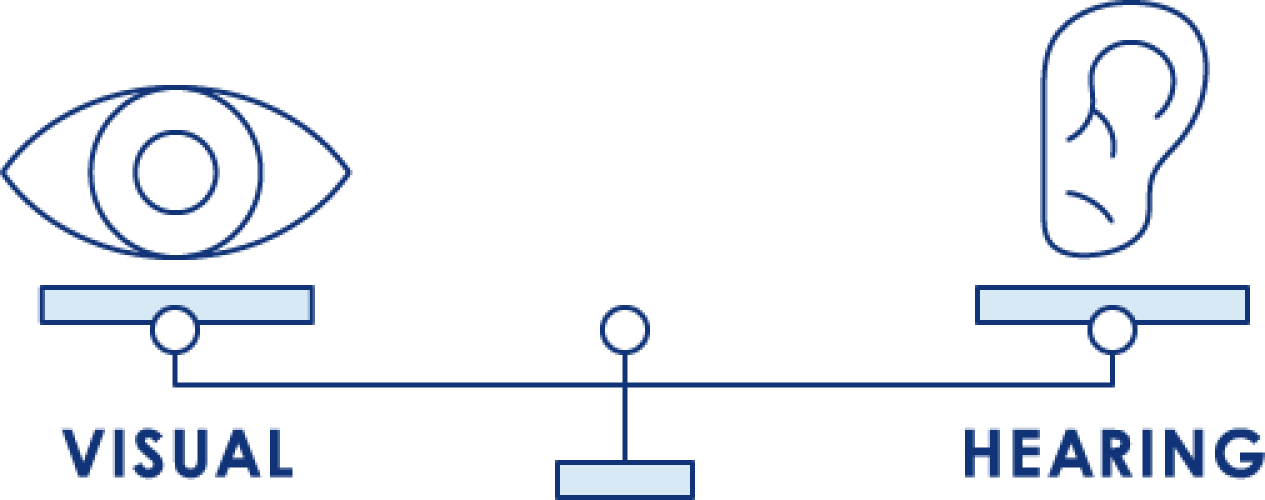
Eyes on the camera
With in-person presentations, it is best to watch the audience as you speak, but online, the whole audience can see each other’s faces on the screen. If you look at the monitor as you speak, you will lose eye contact.It is vital to present into the camera when online. It is hard if you aren’t used to it, but let’s do our best to speak with our eyes on the camera.
Brightness and angle
Laptops are the norm these days, but if you look into the laptop’s built-in camera, you can see is below your line of sight and you will appear to be peering down. For the audience, it will seem as though you are looking down at them, which could start to feel oppressive. Set your camera so that it is slightly above your line of sight. This will improve the way your face looks and give a better impression. Also, ensure that your upper half is on screen, so that your body language and hands are visible.
This is why I recommend using an external camera, rather than the camera in your computer. The angle and position of such a camera can easily be adjusted and, if it is a good model, it will also improve how you look on the screen.
If I were to give you one more tip –and this is something you might not do very much –using a light will make your screen brighter. A single ring light can make a radical difference to the impression you make. Having an upbeat facial expression when presenting is very important.
Did you think about the background?
There are no hard and fast rules when it comes to virtual backgrounds, but it is a good idea if you would like to keep your home private.
When presenting, a business-like background, such as that of an office, will give the right atmosphere. For a sharper virtual background, go for Chromakey. This removes any unnatural effects like messy hair. Folding Chromakey backdrops are available in stores, so give them a try if you’re interested.
Sound is more important than vision when online
Using an external mic will also give you a clearer voice. Mac cameras and mics are good quality, but built-in Windows laptop mics are not so good. If you are making a lot of online presentations, sound quality is more important than picture quality, so investing in a good mic makes sense.
When I make a presentation, I begin by asking my audience to turn off their mics. Feedback and the sound of keys tapping make noise on Zoom. If anyone asks, just tell them they can ask questions in the Q&A afterwards, but for the presentation they need to mute their mic. No problem.
Useful! Recommended Zoom functions for online presentations
To keep the audience’s focus, a presentation must not be all one-way from the presenter. Here are some Zoom functions you can use.

Chat
When you use the Chat function, you create a two-way dialogue with the audience. If you let them know they can type any questions into Chat, they can then participate during the presentation.
Of course, it will be a much more satisfying experience for them to be able to share their own opinions, rather than just listening the whole time.
Polling
This requires you to prepare the questions or options in advance, but with polling, the audience can respond on the spot with a single click. I recommend this because it instantly makes your event more real.
Spotlight
Zoom Spotlight is a very useful feature for presentations, because you can highlight one part of your slide.
Share Screen
There is a bit of a trick to using Share Screen. Click Share Screen located in your meeting controls. Select the Details tab, then click Portion of Screen→ Share Screen. This takes a portion of your desktop and shares it with the audience. Not many people use this function, but I recommend it.
The necessary mind-set for online presentations for which enthusiasm is hard to gauge
The COVID-19 pandemic has made working from home normal,and online presenting is widespread. Before all this began, my presentations at workshops and seminars were always in person, so having to go online all of a sudden was challenging for me, too, to be honest.
The most troubling thing was the difficulty in working out the enthusiasm of the audience. I am used to it now, but at first, I could not make out the reactions of the audience through my screen. In fact, it is impossible to see the reactions of your audience because you are not in the same place.
The answer for me has been: “Don’t worry about it.” What this means is that, when you present in person, it is easy to work out whether what you are talking about is getting through to the audience. However, when presenting into a square monitor, you are up against the fact you are not necessarily going to get a reaction from everyone. It might be that participants are aware of the camera, but a lot of people do not even nod in reaction. Sometimes, people turn their cameras off.
This is an infrastructure that has not been widely used before, so the rules and etiquette have not yet been established for online interactions. Expect the unexpected. Fearing that the audience won’t react can only affect the presenter’s performance, so I have come to a compromise to cut my losses: “Speak with awareness of the audience, but don’t worry about the reaction.”
There is a reason for this. Even if there are no reactions, feedback, or smiles during a seminar, the survey after the presentation can come back with responses like, “It was very clear.” I thought, “Whether or not they were listening, and even if I don’t know their reaction, I got my point across,” and “I need not get depressed.”
On the other hand, even in a real-life presentation, not everyone who nods understands, and not everyone who frowns is unable to understand. In other words, there is no need to worry too much.
Finally, if you are struggling with online presentations, the essentials of presenting are no different.
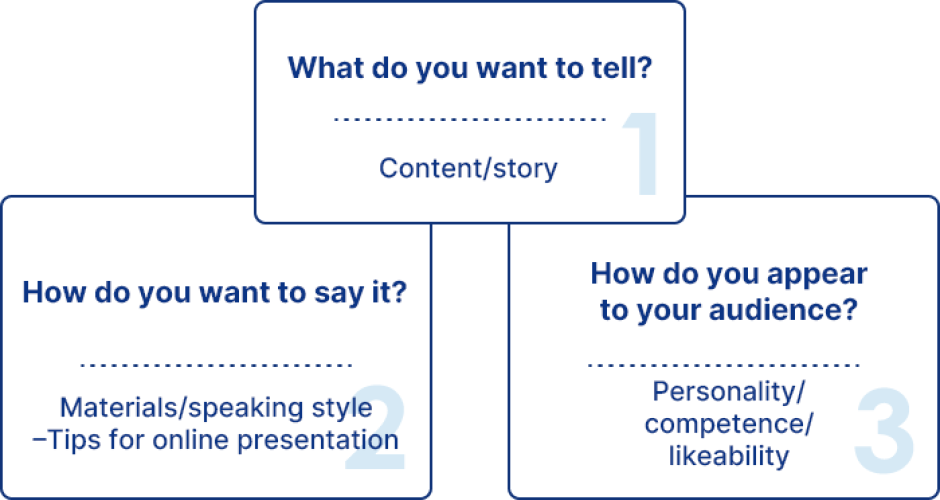
With these three points in mind, you can become a great presenter.

LeadPresentation Producer, Business YouTuber Eiichiro Takahashi, The Presentation University
After graduating with a science degree from the School of Education, Waseda University, in 2003, Takashi joined Hitachi, selling systems to public sector clients. After stints in sales and marketing for banks and planning education start-ups, he joined a start-up to design presentations in 2014 as a core member. He set up and ran a “training project” unusual for the sector, forming and advancing a strategic plan.
In 2016, he set up as an independent presentation producer. He consults on all aspects of presentation, from conceptualization and scenario-building to materials design and communication technologies. He has instructed companies ranging in size from those with annual turnover of a couple of million yen to trillions of yen, and individuals from new professionals to top executives. His main selling point is his authentic and in-depth presentation method, built up in the course of creating his own successes and failures.
In 2019, he started “The Presentation University” YouTube channel. He has also written a book, Ichiban YasashiiShiryosakusei & Prezen no Kyohon(“Textbook on the Easiest Way to Make a Presentation”) published by Impress Books.

